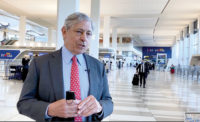A multimodal transportation center envisioned in San Diego could provide the biggest public-private partnership (P3) potential in California. Officials are looking to redevelop a 72-acre Navy site into a hub that will connect transit lines to the airport.
“This is an opportunity to bring P3s to a new level,” said Hasan Ikhrata, executive director of the San Diego Association of Governments (SANDAG). He told attendees of the P3 Airport Summit, held in San Diego July 22-23, that the project could include a mile-long tunnel, 10,000 housing units and 10 million sq ft of office space. The city signed an MOU with the Navy last month and the airport has committed $500 million to the plan.
This fall, SANDAG will commit $50 million for predevelopment pending board approval, said Ikhrata. He added that the board has decided to allow unsolicited proposals.
Panelists encouraged airports to look for P3 opportunities if they are within or next to “opportunity zones,” a federal program designed to create growth for distressed areas. Danielle Rinsler, deputy director of outreach and project development for the U.S. Dept. of Transportation Build America Bureau, said that there are 94 commercial airports within the opportunity zones.
Another P3 airport project is on the verge of taking off. The $13-billion planned redevelopment of John F. Kennedy International Airport includes a $7.5-billion rebuild of Terminal 1, replacing Terminal 2, occupying the site of the former Terminal 3 and connecting to Terminal 4 with 23 gates. Construction is expected to start next year.
McKissack & McKissack leads the program management oversight team for Terminal 1. The P3 team is Terminal One Group Association (TOGA), a innovative coalition of airlines, labor, minority- and women-owned businesses and financial partners that include The Carlyle Group; JLC Infrastructure; Ullico; and Munich Airport International. TOGA airline partners are comprised of Air France, Lufthansa, Korean Air and Japan Airlines.




Post a comment to this article
Report Abusive Comment